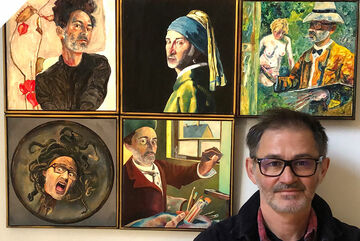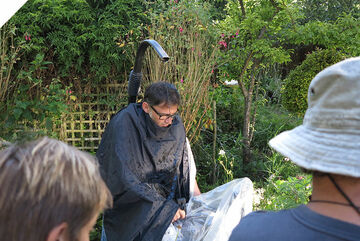Action! Scene! - And everything in between
Interview with DoP and painter Martin Szecsanov
Mar 21, 2024
Two years ago Martin Szecsanov - Hungarian cinematographer, musician, painter and gallerist died at the age of fifty-five. We remember him with our interview from 2021.
In recent years he has shot feature films, commercials and short films. If you look only at the major ones shot in this country, X - Deleted from the system, or BUÉK, you can see how different the images and worlds are. Martin Szecsanov worked in Turkey and Kazakhstan as well, where besides the tasks, the attraction was at least as much that although the professionalism of the filmmakers is the same as anywhere in the world, life, the pace is much slower, and thus the stress is also much less than even in our own country.
Unfortunately, many of these jobs have been cancelled due to the pandemic, especially by foreigners. What has been done instead? "With the remaining shoots, there is perhaps a little more time for painting," we learn from the cameraman. Six years ago, he and his friends rented a room in Várfok Street at a municipal auction, which became Fest;tisztít. It was here that he exhibited his paintings about a year ago, although the gallery, like so much else, was mostly closed last year. But now let's look at the timeline backwards: how did a little boy who loved painting and won an asphalt drawing competition become a sought-after cameraman?

Sofia and sombrero
While the parents were working, little Martin was often looked after by the Bulgarian grandfather who could translate from five languages, and it vividly remains in his memory how, while the keys clattered on the Erika typewriter or on another one with Cyrillic letters, he would be drawing. So this is where Martin Szecsanov’s relationship with pictures began, and his answer to the question of what he wanted to be at that time was clearly a painter. He also remembers the first exhibition he saw with his favourite aunt. "In '72, there was a Chagall exhibition at the Műcsarnok, which had a quite big impact on me. I simply decided that I too would paint" - he says of his first art experience.
His entire childhood was rich in movie-like scenes, one only needs to recall the film viewings in Sofia with his aunt. It so happened that this relative, a film aesthetician and art historian, specialized at the time in Latin American films. "We watched a lot of black-and-white films together, featuring guys in sombreros shooting, then dying for minutes on end. After the movies, a constant program was the Sofia Budapest Confectionery" – we learn even more about the cultural and gastronomic influences of his childhood.
The same aunt paved the way for his first film, in which he was already actively involved. At the age of nineteen, when he was looking for a job after graduating from the Prater School of Photography, János Dömölky started shooting Dawn Roofs. Because of a family connection, word followed word until the director asked him the question: 'Would you like to be a lighting technician or assistant cameraman?' "I'm interested in lights," Martin replied, and so he became a lighting technician for a few years. Step by step he got closer to the camera, became an assistant cameraman and then a focus puller. In the meantime, he and his friend Attila Herczeg - who was first assistant at the time - started shooting music videos. It was the early 2000s, he had a band, he was designing album covers, it was a golden age, if you like, in terms of creative diversity. He learnt his trade in practice and gradually, until he himself said what many people had already suggested: become a cameraman! For a long time he worked as a focus puller and mainly as a cameraman for clips.

Advertising buzz
At that time, Felicia Kovács made an offer from Argus Film, and from then on Attila became a commercial film director and he became a cinematographer. There he found himself in the middle of the advertising business, with a succession of commercials for the biggest companies. "I was lucky, because my former colleagues in the industry all saw mine as a success story". Martin, who had been working as a team player, also heard the ideas behind the camera: "It's always worth listening to what other people have to say, I've always liked teamwork the most in filmmaking".
And the portfolio has become more diverse: commercials, clips, feature films, short films. "They all move me, they all bring out different skills and they can be lacking because of their uniqueness," says the cinematographer of the different challenges of the different genres, "but the most important thing is that whatever I have to shoot, whatever the budget, whoever the client, my approach is always the same. I have to make the best of it to the best of my ability," is the essence of Martin's work ethic.
Whatever the film is, there is always a lot of pre-production work before shooting, and this is especially true for commercials, where, in addition to the usual film pre-production work, there is a lot of coordination with the client, and shooting can start when everyone has the same idea about everything. Here, improvisation is the rarest case, everything is precisely planned. "The essence of advertising is compression, everything has to be said in seconds, and by the time the camera starts rolling, it's almost stopped. I'm fascinated to this day by the amount of preparation that goes into filmmaking, and then suddenly, on the day, everyone is there, the tech is ready, the actor arrives in make-up and costume, and the two magic words are ‘action’ and 'that's it'. It's a kind of magic for me, again and again," he says of his most important drive. While for him, being a cinematographer also offers the complex experience of being "a technique and an art, but there's a lot of math".
The silence of the canvas
The meditative silence of painting, a childhood dream, is a perfect accompaniment to the hectic, stressful work. It's both relaxing for him and a real sense of achievement when something really comes together. "What I love about it is that when I paint, it's all up to me and I have only myself to blame for any failure or even success. Painting is an individual sport, and it's interesting because I like team sports in real sports, and in filmmaking I particularly enjoy team sports, but painting is different!"
Moreover, nowadays he doesn't just paint, but their "hobby gallery" with Attila Csáky has become an important part of his life. The venue for exhibitions, which changed every month until last spring, has become a club venue with concerts, where old faces pop up from time to time at an opening. "I enjoyed not only the social life in it, but also being the handyman there, lighting, installing, bringing the toilet paper if we ran out."